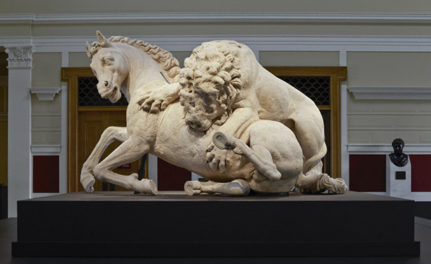
Statue of a Victorious Youth (The Getty Bronze), 300–100 B.C., Greek. Bronze with inlaid copper, 59 5/8 in. high. The J. Paul Getty Museum, 77.AB.30
“The only way for us to become great or, if this be possible, inimitable, is to imitate the ancients.” —Johann Joachim Winckelmann
“Even the beautiful must perish!” —Friedrich Schiller
Statue of a Victorious Youth stands proudly on display at the Getty Villa. The Greek sculpture—also known as the Getty Bronze and the Victorious Youth—was discovered in 1964 by fishermen in the Adriatic Sea.
The Victorious Youth is a young athlete, just crowned in the aftermath of a competition. He emphatically points to the wreath on his head with his right hand, while his left arm may once have cradled a palm branch, a symbol of victory. His strong leg muscles indicate that he is a runner, but his cavalier attitude suggests he is not a professional athlete but a nobleman participating in the races.
Scholars have strained to determine the athlete’s identify. Some have linked him to historic figures such as Demetrios Poliorketes or Seleukos Nikator. Others believe him to be the mythological hero Herakles or the physical embodiment of Agon—victory in athletic competition.
One thing is certain: the left side of the statue is particularly flat, suggesting that the youth was originally joined by another figure. It could have been a proud father, celebrating his son’s success, or the referee involved in the moment of coronation.
The sculptor likely wanted to create a figurative model to represent the new generation of victorious condottieri, or military leaders, who, led by Alexander the Great, conquered Greece and the eastern Mediterranean.

My poem is triggered by the sense of death, fragility, and vacuity that even our masterpieces, which we perceive as eternal, cannot escape. The uncertainty of the statue’s attribution, the uncertain nature of the athlete’s identity, and the disfigured, fragmentary condition of the bronze inspire me to speak of the transience of life, the impossibility of every real victory, and the meaning of time for human beings.
Poem read by Robert Davi
“The Victorious Youth”
by Gabriele Tinti
Where now is your garland of olive?
Where your rapid supports?
Where the judge who placed
on your head the precious wreath?
We are not even given to know who you are.
Your haughty yearning is lost in the void now,
the contest is deserted, the shouts and the glory far away.
All is calm, icy silence, cold quiet there where you are
because all is vain and all disappears and you too
like us will not be able to save yourself
from that darkness, that abyss
where there is no more past or future
where there will be no more possible
memory of man.
* * *
Look closely, it is not as you think.
My flesh is bronze, it wastes away,
it does not bask in the warmth of laurels.
My blood is clear, it flows fast.
I looked in your eyes for the source,
the reflection, the survival of things.
I tried to burn down the world,
to shine and make you throb.
Do you really think it is so easy?
Those like me are ready for anything,
they risk their lives, shake the sky,
close themselves in without quivering.
I know, your parade will not be slow in coming.
You will take me into the light like a relic,
you will take me to pieces, you will feast ravenously
on my remains in the night sacrifice.
I would have liked your gaze on me,
to hear the voices of the crowd exalt,
to shake you with my glory, to puncture
the skin, that which remains of the silence.
I would have liked to pierce you with the impossible,
to shatter every boundary, to make you encroach
and then repeat it all, to win
the race against time, to continue.

See all posts in this series »




Comments on this post are now closed.